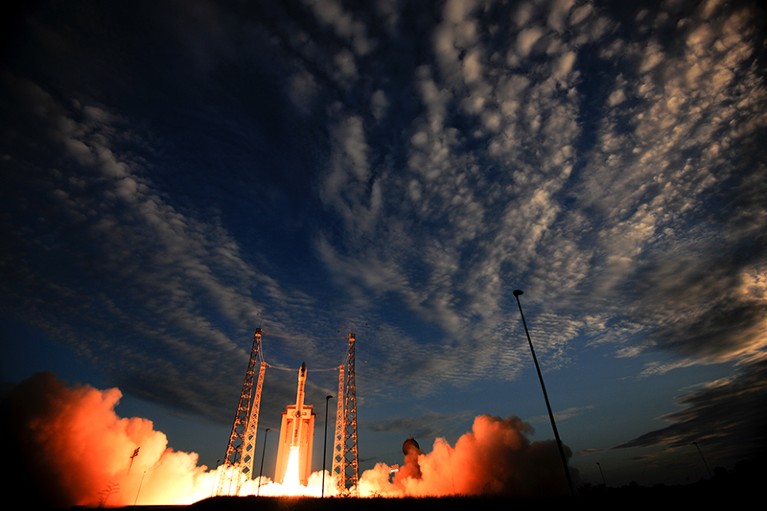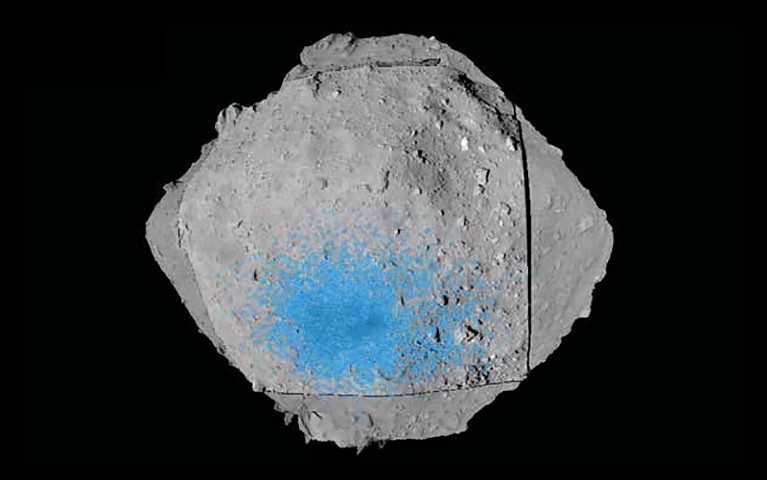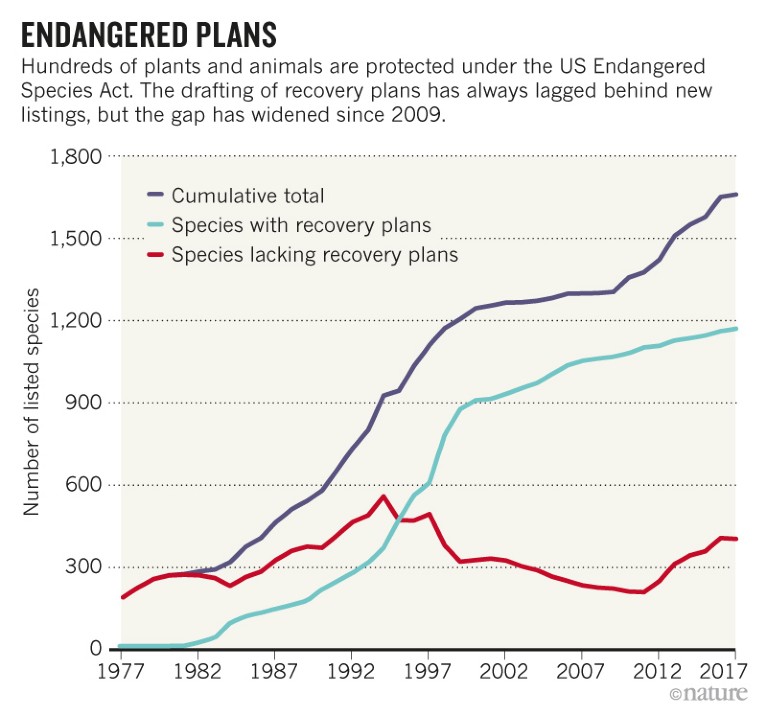EVENTS
Wind-mapping satellite takes flight The European Space Agency’s (ESA’s) Aeolus satellite soared into space on 22 August for a three-year mission to monitor wind around the globe. Aeolus is the world’s first wind-mapping satellite and launched atop a Vega rocket from Europe’s spaceport in Kourou, French Guiana. Mission controllers will spend the next several months calibrating the spacecraft’s instruments, including an ultraviolet laser system that will measure the speed and direction of winds in the atmosphere’s lowermost 30 kilometres. ESA approved the Aeolus mission in 1999, but development of the satellite’s instruments took much longer than expected. The complexity of building a powerful ultraviolet laser that could operate in a vacuum was the main issue. Once Aeolus starts its scientific observations, data from the mission will be incorporated into numerical weather predictions to improve forecasts from national weather agencies.

The Aeolus satellite launches into space. Credit: S. Corvaja/ESA
POLICY
Japan gene editing A government panel in Japan has recommended that the country does not impose regulations on gene-edited organisms. The recommendation, if implemented, would mean that plants or animals that have had their genomes edited at specific locations using tools such as CRISPR would not be subject to the same regulations as genetically modified (GM) organisms. GM organisms, into which foreign DNA has been introduced, cannot be produced without government approval. Although permission would not be required for gene-edited organisms, researchers would have to register them with the government, with the exception of microorganisms that remain in the laboratory. The recommendation is in line with US policy, but contrasts with a July decision by the European Union’s highest court that gene-edited organisms should not be exempted from existing regulations. Japan’s government intends to convene another panel to review the decision. Currently, no GM crops are grown commercially in Japan.
Power-plant rules On 21 August, the US Environmental Protection Agency (EPA) revealed its long-promised plan to relax federal limits on greenhouse-gas emissions from power plants. The proposal targets former president Barack Obama’s flagship climate regulation, the Clean Power Plan, which sought to reduce carbon dioxide emissions from the power sector to 32% below 2005 levels by 2030. The EPA proposal would allow states to set their own emissions-reduction goals and emphasizes the use of energy-efficiency technologies at the scale of individual power plants. If finalized and implemented, the proposal will replace the Clean Power Plan, which was introduced in 2015 but blocked by the Supreme Court in 2016 pending a legal review. The EPA will accept public comments on the draft rules for 60 days before finalizing them.
‘No-deal’ Brexit plan The UK government has released guidance about what will happen to research funded by the European Commission should Britain leave the European Union without making a deal. The document, published on 23 August, warns that the United Kingdom will be relegated to “third country” status in the European Commission’s €80-billion (US$93-billion) main research-funding programme, Horizon 2020, if no agreement is reached. This will restrict the types of funding researchers in the United Kingdom can bid for. The United Kingdom will leave the EU on 29 March 2019, and scientists could lose access to grants from the European Research Council, which funds basic research, and some parts of Marie Skłodowska-Curie Actions, which facilitate researcher mobility. The guidance reiterates the government’s 2016 pledge to underwrite the cost of any projects that extend beyond Brexit, if scientists secured the grant before exit day.
RESEARCH
Conductor claims Two teams of physicists have reported hints of superconductivity — the ability of a material to carry a current without resistance — at record-high temperatures. One team, led by Mikhail Eremets at the Max Planck Institute for Chemistry in Mainz, Germany, posted a preprint on the arXiv server on 22 August that reported a drop in electrical resistance in a lanthanum-hydrogen compound cooled to below –58 ° C (A. P. Drozdov et al. Preprint at https://arxiv.org/abs/1808.07039; 2018). If confirmed, it would beat the previous record of –70 °C, which the same team obtained in 2015. Then, on 24 August, Russell Hemley of the George Washington University in Washington DC and his colleagues reported preliminary evidence of even more astounding transition temperatures, –13 °C and +7 °C, in a similar material (M. Somayazulu et al. Preprint at https://arxiv.org/abs/1808.07695; 2018). Both methods required squeezing the samples between diamond tips under extreme pressures. The teams are now working to confirm that the materials are superconductors.
SPACE
Asteroid sites On 23 August, the Japan Aerospace Exploration Agency revealed the sites on the asteroid Ryugu at which its Hayabusa2 spacecraft will touch down to collect a sample to bring back to Earth — and where it will drop the first two of its four landing probes. Hayabusa2 left Earth in 2014 and reached Ryugu in June. Mission planners faced tough choices for landing sites because the body is strewn with boulders. To minimize risks for one probe, called MASCOT, mission scientists ran simulations of the surface to produce ten options, and picked one spot on the asteroid’s southern hemisphere. The choice reflected various criteria, including average temperatures on the ground. Hayabusa2 will temporarily descend to an altitude of 60 metres to drop MASCOT, and will make its first touchdown in late October, at a site north of Ryugu’s equator. The first of three MINERVA-II probes is scheduled to land in late September.

The MASCOT landing site (blue).Credit: JAXA
PEOPLE
Frieden arrest Tom Frieden, who directed the US Centers for Disease Control and Prevention from 2009 to 2017, was arrested and arraigned in New York City on 24 August. Frieden was charged with forcible touching, sex abuse and harassment, according to the New York City police department. The charges came after a 55-year-old woman filed a report with police on 7 July accusing Frieden of groping her buttocks in October 2017. On 24 August, a judge ordered Frieden to avoid contact with the alleged victim and released Frieden on his own recognizance. “The allegation does not reflect Dr. Frieden’s public or private behavior or his values over a lifetime of service to improve health around the world,” a spokesperson for Frieden said in a statement.
Science minister The Australian government appointed Karen Andrews as the minister for industry, science and technology on 26 August. Andrews was selected by the new prime minister, Scott Morrison, who took up the position two days earlier, following a leadership challenge from another minister that ousted former prime minister Malcolm Turnbull. Turnbull lost the support of his party over an energy policy that sought to reduce the cost of electricity and cut emissions. Andrews, a former engineer, was assistant science minister from September 2015 to July 2016. Science-advocacy groups say she has been a strong supporter of science and research. Her appointment also puts the position back in the government’s inner executive circle, after it was removed in December 2017.
FUNDING
NIH investigation The US National Institutes of Health (NIH) is investigating about half a dozen institutions with agency-funded researchers who might have failed to disclose monetary support from foreign governments. NIH director Francis Collins spoke about the investigation during a 23 August hearing before a US Senate committee. Earlier that week, the agency sent a letter warning NIH-funded institutions about attempts by foreign governments to influence US research, or to steal intellectual property and other confidential information. The NIH has also set up an advisory panel that will establish methods for accurately reporting all sources of research funding and mitigating security risks to intellectual property. Collins further encouraged institutions to meet with the US Federal Bureau of Investigation about these issues as they pertain to biomedical research.
TREND WATCH
The number of endangered species for which the US government has no recovery plans has grown steadily over the past decade, according to an analysis this month (J. W. Malcom & Y.-W. Li Conserv. Biol. http://doi.org/cs9r; 2018). The plans, which are mandated under the Endangered Species Act, detail the threats against a species as well as the ‘nuts and bolts’ strategies that will help the species to recover.
Researchers used publicly available data from the US Fish and Wildlife Service and the National Marine Fisheries Service, the agencies tasked with developing recovery plans, to work out how many species lacked such safeguards and how that has changed since 1978. They found that of 1,548 eligible species, 24.5% were without a plan.
The analysis also showed that the number of plans has always lagged behind the number of species listed, but that the gap has widened since 2009, when the rate of listings increased.“There isn’t enough funding for the services to close that gap,” says lead author Jacob Malcom, a conservation biologist at Defenders of Wildlife in Washington DC. And without the plans, he says, people may be unwittingly hindering species’ recovery.




